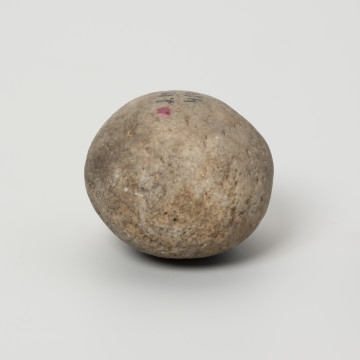
Hammer
7800 p.n.e. — 7000 p.n.e.
National Museum in Szczecin
Part of the collection: Stone Age
Site 19 in Szczecin-Jezierzyce, located east of the Oder River in the southeastern part of the city, is considered to be one of the most important Mesolithic sites in Western Pomerania. The literature describes it primarily as a Late Mesolithic site. However, detailed analyses suggest that most of the flint evidence is a remnant of the Middle Mesolithic settlement. Furthermore, the site shows traces of multiple occupations by different groups of people from the Late Palaeolithic to the Late Neolithic. One of the most interesting finds, discovered at the site during the 1974-1975 excavations, is a polishing tablet very likely linked to the Late Neolithic Corded Ware culture. Named after distinctive decorations on vessels created by pressing coils of cord around the necks and spouts of vessels, this culture is generally dated to the 3rd millennium BC. The polishing tablet made from a flat piece of reddish-orange sandstone at one end shows visible traces of work on a straight surface, suggesting that it was created by dividing a larger body of the sedimentary rock into layers. The owners of the plate closely observed the established boundary between the working surface and the base, as the top side has been clearly evened out, while the underside shows no traces of such doing. Earlier Stone Age and Bronze Age communities used polishing tablets to work high-quality flint products such as axes and daggers. The purpose of polishing was to strengthen the edges of these tools before further handling or use. Contrary to popular belief, it was not the tablet itself that abraded the flint, but the bedding, which was usually used wet. The same tablet may have been used in many stages of tool polishing depending on the type and thickness of bedding applied - from preliminary smoothing with coarse gravel or flint rubble, through sand polishing, to polishing with clay or dust. Michał Adamczyk
Author / creator
Object type
polishing tablet
Technique
hard-hammer knapping, grinding
Material
sandstone
Origin / acquisition method
field research
Creation time / dating
Creation / finding place
Owner
Muzeum Narodowe w Szczecinie (1945- )
Identification number
Location / status

7800 p.n.e. — 7000 p.n.e.
National Museum in Szczecin

80 — 160
National Museum in Szczecin

5250 p.n.e. — 5000 p.n.e.
National Museum in Szczecin
DISCOVER this TOPIC
National Museum in Lublin
DISCOVER this PATH
Educational path